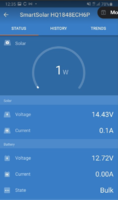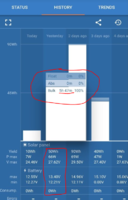First up, a HUGE thanks to everyone on this forum who has been helping me - if it wasn't for the help and input of the people on this forum I would have zero idea of how to prove if there is an issue or not.
So,
I think I have another significant piece of information relating to the issue with the solar panel which proves the issue - please read on. Cast you minds back to the situation I had two days ago. Where the panel showed 38W with 2.9A going into the battery, and as soon as I started to give the roof a clean, it dropped for no obvious reason to 0W and 0a going into the battery. I had done nothing, apart from give the panel a gentle wipe over / clean.
So, as it is another sunny day today, I thought I would try and reproduce the issue again. I have spot checked the readings via Bluetooth throughout the morning. From around 10:30 (a bit misty) the panel was doing around 25W, and this went up as the morning progressed. As it got toward mid-day the panel was up to pretty much 50W, so I decided to see if I could reproduce the "drop to 0W issue", by giving the panel and roof a clean / wipe over.
However, even before I started, I noticed something a little odd. As I was actually watching the bluetooth screen, something odd happened. Although the sunny conditions had not changed, the readings went from 50W down to about 18W (state still showing as in bulk). It then bounced between 18W to 30W for a bit, before finally returning to around 50W. As it had returned to 50W again, I didnt think too much more about it.
I took the screenshot below, at 11:45 just before I got prepared to wash the panel and roof (this was about 5 minutes after I noticed the watts bouncing up and down a bit):

So, good levels of charge going in at that specific point.
9 minutes later, I was ready to start cleaning the roof, but had NOT started yet. I connected the bluetooth so I could watch the figures as I actually cleaned. But... low and behold, it had gone down to zero on its own, before I had even started to clean anythying. I was just about to start at that point, the roof was completely untouched. Here are the figures:
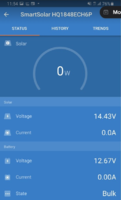
Note that the state is still bulk, showing it is "trying to charge", but there are 0W so it cant. To me It does not look as if the panel had just gone into ABS or float mode, as the app still displays state as "bulk". Also, as the leisure battery is showing as only 12.67 volts at that time, surely it should be charging if it can (i.e. the battery does not looked fully charged based on the voltage)?
It stayed in "bulk" state for another 5 minutes, but the panel volts continued to slowly drop. After about 10 minutes of it being 0W, the state changed to "OFF" as shown below.

Just to check the display was not lying, I left it another 30 minutes and looked in the history to see if it has recorded any time in ABS or FLOAT modes, and it has not. The history showed an additional 30 minutes in "bulk mode" at this point, and not time in float / abs modes (see below).
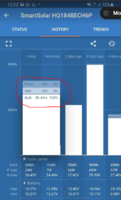
So,
the million dollar question.... Can I take this latest episode (together with the incident from 2 days ago) as evidence there is definitely an issue with the panel? Or is there a valid reason I dont understand that explains why it could suddenly drop from 38W to 0W 2 days ago, and now today from 49W to 0W in the space of a few minutes? If this is categoric evidence I will get back on to the converter now. Thanks again everyone!
For completeness, here are the two screen shots from when the
same thing happened two days ago.
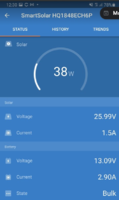
Went from 38W to 1W (and then zero soon after) within 5 minutes.
